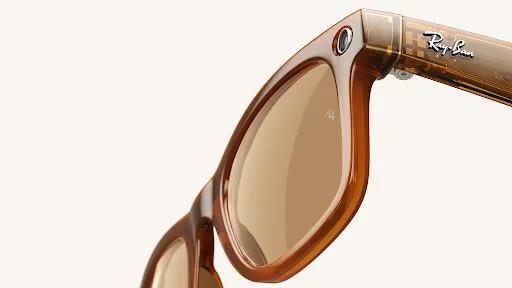Ray-Ban Meta Smart Glasses: Design, AI, and Future Outlook
-
Last Updated:
04 Sep 2025
-
Read Time:
8 Min Read
-
Written By:
 Harshita Toplani
Harshita Toplani
-
2840
Table of Contents
Step into the world of Ray-Ban Meta Smart Glasses, where classic style meets smart innovation. From sleek design and AI features to improved cameras, audio, and live streaming, experience how they outshine Ray-Ban Stories and Snap Spectacles.
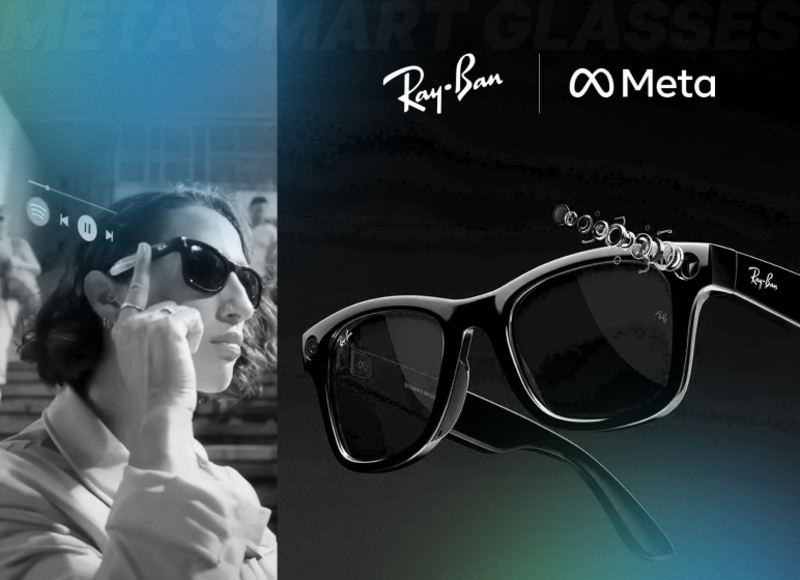
Do you love the look of classic Ray-Bans but wish your glasses could do more than just block the sun? What if they could capture the moment while you’re on the go, let you share it instantly, or even handle simple tasks without you reaching for your phone? That’s exactly what Ray Ban Meta Smart Glasses bring to the table.
Think of them as your everyday pair of shades, but enhanced. A few key features include improved cameras, enhanced audio, and live streaming capabilities, all presented in the timeless style that Ray-Ban is renowned for. At a concert, traveling, or just hanging out with some friends, these glasses keep you connected and do not interfere with the ambience of the moment.
The best part? They look and feel like real Ray-Bans. No bulky headgear, no awkward “techy” vibe—just iconic frames with a new layer of convenience built in. Of course, as with any new gadget, questions come up about price, privacy, and whether they’re really worth it.
In this guide, we’ll take a closer look at the design of Ray-Ban Meta Smart Glasses, explore what they can actually do, and see where they might be headed next.
The Evolution from Ray-Ban Stories to Meta Ray-Bans
Ray-Ban’s entry into smart eyewear began with a collaboration between Meta (then Facebook) and EssilorLuxottica. In 2021, they launched Ray-Ban Stories, which looked like the brand’s iconic frames but added hidden features such as cameras, microphones, speakers, and touch controls, all in a lightweight and stylish design.
Ray Ban Meta glasses were introduced in October 2023, marking the beginning of the next generation. These provided crisper cameras, clearer audio, longer recording times, and increased durability while maintaining the traditional Ray-Ban look.
While Ray-Ban Stories demonstrated a union between fashion and technology, Ray Ban Meta AI glasses build on this premise, offering smarter functionality, yet without compromising on the iconic classic style of the brand.
Heritage & Brand Legacy of Ray-Ban
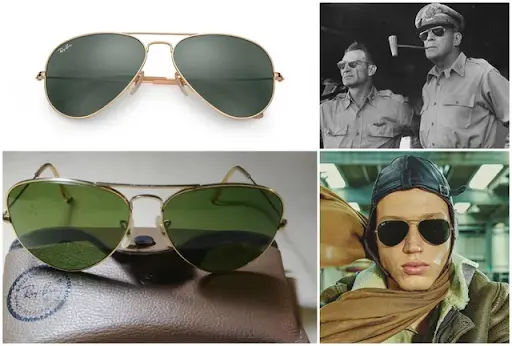
From the Aviator sunglasses made for U.S. Air Force pilots in the 1930s, Ray-Ban has influenced fashion and culture ever since. As the Wayfarer and Clubmaster designs made their way into music, movies, and fashion, the brand would eventually become a cultural icon. To put it another way, Ray-Bans have developed from eyeglasses to a symbol of uniqueness, self-assurance, and classic style that appeals to all ages.
How Ray Ban Meta Glasses Build on a Storied Eyewear History

Few brands can truly reinvent themselves without losing their soul, and Ray-Ban has truly found equilibrium in that. From frames of generations, the brand has now confidently stepped into smart eyewear. The result is Ray Ban Meta Sunglasses: timeless design fused with subtle innovation.
These glasses maintain the timeless style that is synonymous with Ray-Ban. In a subtle way, they contain little cameras, open-ear speakers, microphones, and touch controls. Forbes calls it proof that fashion and technology can co-exist peacefully without the former overshadowing the latter.
At their core, Ray-Ban Meta glasses are about evolution, not reinvention. They let wearers enjoy the same iconic style while gaining practical tools for modern life, showing how a brand rooted in tradition can still shape the future.
Genesis of Meta Ray Ban Glasses (Ray-Ban Stories)

Ray-Ban Meta glasses were always meant to pair classic style and some very useful smart features. Step one in this journey commenced with the release of Ray-Ban Stories, a show that delights in fashion and technology working side by side without compromise.
Collaboration Between Ray-Ban and Meta
- Partnership: In 2021, EssilorLuxottica, the parent company of Ray-Ban, partnered with Meta (then Facebook) to develop fashionable eyewear with integrated technology.
- First Launch: This collaboration led to Ray-Ban Stories, eyewear that could capture photos and videos, play music, and handle calls hands-free.
- Engineering Challenge: The largest challenge was incorporating speakers, microphones, and cameras into thin frames without sacrificing the iconic Ray-Ban style.
- User Experience: To make sharing seamless, Meta introduced the Facebook View app for managing photos and videos.
- Evolution: Over time, updates added sharper cameras, improved audio, and AI features, laying the foundation for today’s Ray-Ban Meta glasses.
Meta teamed up with EssilorLuxottica, Ray-Ban’s parent company, to pull it off. Think of it as style meeting circuits, with the mission to make smart glasses that feel like regular eyewear but come with a hidden layer of cool tech.
Design Goals of the First Smart GlassesWhen Mark Zuckerberg first teased Ray-Ban Stories, he called them an “important step on the road to developing the ultimate augmented reality glasses.” In plain speak, he wanted your favorite shades to get smarter without making you look like a sci-fi extra. The idea was bold yet simple, keep the iconic Ray-Ban look while slipping in tech that feels natural. Meta teamed up with EssilorLuxottica, Ray-Ban’s parent company, to pull it off. Think of it as style meeting circuits, with the mission to make smart glasses that feel like regular eyewear but come with a hidden layer of cool tech. |
|
Launch Details and Features of Ray-Ban Stories
Ray-Ban Stories launched in September 2021 as Meta’s first smart glasses after nearly two years of collaboration between Meta’s Reality Labs and EssilorLuxottica. Designers and engineers worked to blend tech into classic Ray-Ban frames, keeping them stylish and lightweight. Priced at $299, they debuted in Ray ban meta wayfarer, Round, and Meteor styles with multiple lens options.
Key features in Ray-Ban Stories included;
- Dual 5MP cameras for photos and short videos with a recording light
- Open-ear speakers for discreet audio playback
- Three-microphone system with noise suppression
- Touch controls on the temples for quick actions
- Facebook View app for editing and sharing content
- Slim, comfortable design that feels like regular sunglasses
- Privacy tools like a power switch and an LED indicator
Meta Engineering & Ray-Ban Meta Development
While Meta engineers were engineering the Ray-Ban Meta glasses with zeal, the peak of the challenge was really cramming cameras-mics-processors-batteries into frames that would look and feel like classic Ray-Bans. They had succeeded in striking a balance between comfort and top technology without compromise.
Technical Challenges in Creating Ray Ban Meta Smart Glasses
- Hardware had to be miniaturized to fit into slim frames while managing heat, power, and thickness.
- Engineers developed a bass reflex mic system and ran extensive tests to ensure durability and charging safety.
- Flexible circuit boards were designed to sit in the hinges, enduring thousands of folds while still holding everything in place.
User-Centered Design Approach
The team started with the look people already loved and worked backward to make the tech fit. The goal was to keep the glasses iconic, wearable, and natural. Even during the pandemic, testing continued through improvised setups, with prototypes being refined in real time.
Form Factor and Style Constraints in Meta Ray-Bans
Every detail had to disappear into the design, leaving no bulky edges or futuristic bulkiness. The result was frames that looked like your favorite Ray-Bans but added smart features such as hands-free calls, photo capture, and open-ear audio. It was a careful balance of real-world comfort, classic fashion, and discreet technology.
The Next Step: Ray-Ban Meta Glasses
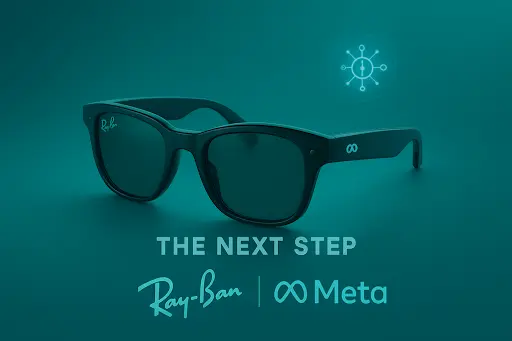
The Reality Labs team at Meta treated the next generation of Ray bans meta glasses like a stylish scientific sprint. Hour upon hour of research kept them pushing boundaries of the tech all while staying true to what makes Ray-Ban iconic.
-
Ray-Ban Meta Launch Timeline
- 2021 marked the debut of Ray-Ban Stories, the first smart glasses to blend classic frames with hands-free capture and media playback.
- October 17, 2023, saw the arrival of Ray-Ban Meta glasses, a sleeker and smarter follow-up that raised the bar in design and performance.
- July 2025 brought software updates for the second generation, proving that improvements would continue even after launch.
- Late 2025 (expected) is anticipated to bring the third generation, potentially featuring a built-in display and expanded AI capabilities, likely revealed at a Meta Connect event.
-
Hardware Improvements in meta ray ban smart glasses
-
The Meta upgrade brought up sharper 12MP cameras, crisp 1080p video, open-ear speaker clarity, longer battery life, and faster processors. They came in frames that still felt lightweight and unmistakably Ray-Ban.
-
-
Meta AI Integration in Ray-Ban Meta
-
This generation goes beyond hardware with smarter interactions. Simply saying "Hey Meta" gives users access to voice-based assistance, real-time translations, and immediate environmental information. Technology feels like a natural extension of daily life thanks to the glasses, which change with the wearer.
-
Gen 1 vs Gen 2: Ray-Ban Stories vs Ray Ban Meta Smart Glasses
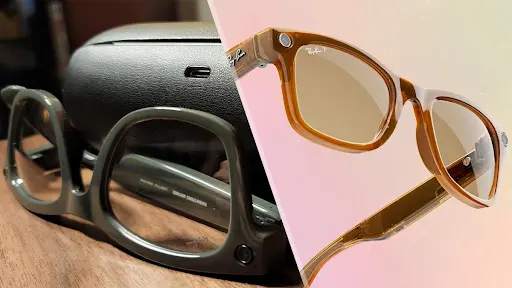
If you’re debating whether to upgrade from Ray-Ban Stories to Ray Ban Meta smart glasses, here’s a quick breakdown. Think of it as swapping your shades for an upgrade packed with smarts and swagger.
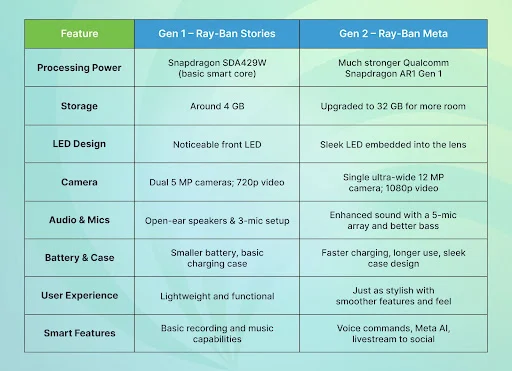
Gen 1 proved smart glasses could fit inside Ray-Ban’s classic frames, offering recording, music, and calls. Gen 2 took it further with a faster chip, bigger storage, and sharper design. The LED is now subtle, the battery lasts longer, and the overall feel is smoother.
In short, Gen 1 was proof that smart Ray-Bans could exist. Gen 2 made them shine—even brighter.
Use Cases & Market Reception of Ray-Ban Meta
Ray-Ban Meta glasses have moved past the “cool experiment” stage into something people actually want to wear. They blend classic Ray-Ban style with smart features powered by Meta AI. Not full AR yet, but enough to make everyday life easier and more stylish. The market has caught on fast, with sales proving this collab is more than a passing trend.
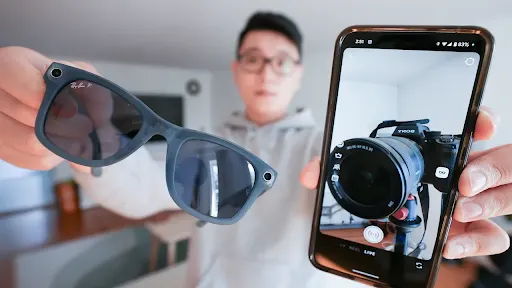
Why Content Creators Choose Ray-Ban Meta Glasses
Creators love these glasses because they let them capture life hands-free. Quick photos, POV videos, or a live stream all happen with a tap or voice command. The result feels natural and authentic, showing the world exactly how the creator sees it.
Plus, they look good on camera. With iconic frames, clear audio, and smooth social sharing, the glasses double as both a tool and a fashion accessory.
Ray-Ban Meta for Mainstream Users and Fashion Tech Fans
For everyday users, it is about convenience without losing style. You can take calls, send messages, translate, or ask Meta AI for help, all without pulling out your phone. Fitness fans like them for outdoor workouts, while fashion lovers treat them as a statement piece with extra perks.
The second-gen launch hit much harder than the first. Sales are climbing fast, showing that people are ready to pay for smart features wrapped in a frame that still feels timeless.
Ray-Ban Meta Price and Value Considerations
Priced from $299, they cost more than regular Ray-Bans, but you get cameras, AI, open-ear speakers, and hands-free control built in. The value is in the subtlety — they look like stylish eyewear first, smart glasses second.
Sure, the camera won’t beat a smartphone in low light, and battery life has limits. But for those who want everyday tech that doesn’t look like tech, the ray-ban meta price feels worth it.
Controversies & Challenges with Ray-Ban Meta Smart Glasses
With every wave of new tech, excitement often comes with a dose of worry — and Ray-Ban Meta smart glasses are no exception. For all their cool features, they have sparked heated debates around privacy, ethics, and data security. From hidden recordings to fears of mass surveillance, the glasses are as controversial as they are stylish. Let’s unpack the biggest concerns.
Privacy Concerns Around Ray-Ban Meta GlassesOne of the biggest red flags is recording without consent. While Meta added a small LED light and sound alert to show when the glasses are capturing, critics argue that it’s easy to miss — especially in crowded or dim places. People worry about being filmed without realizing it, making these glasses feel like walking surveillance tools. Meta insists the glasses only listen after hearing “Hey Meta,” but the fact that your voice commands can be sent to their servers hasn’t done much to calm skeptics. To many, it feels less like smart eyewear and more like smart eavesdropping. Facial Recognition Ethics and Ray-Ban Meta |
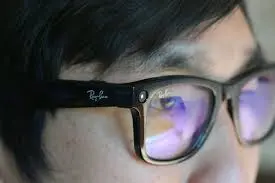 |
For now, Meta has stayed away from rolling out facial recognition, citing ethical concerns, although the reports indicate exploration for future versions. The backlash is loud: critics warn of bias, profiling, and surveillance creep, with advocates calling for stricter regulations and independent oversight before this tech leaves the lab.
Data Security and Corporate Responsibility
Beyond recording and recognition, there’s the issue of who controls the data. How long is it stored? Who has access? Could it be hacked or misused? These questions remain murky. Regulators in Europe have already flagged compliance issues under GDPR, urging Meta to prove stronger safeguards.
While Meta does provide privacy settings, opt-in controls, and reminders to “switch off in sensitive places,” critics argue that these are small fixes to much bigger systemic risks. Without clearer laws and more transparency, the unease around data misuse is unlikely to fade.
Outlook for Ray Ban Meta Smart Glasses
Meta ray ban smart glasses have a bright future. According to a Meta press release, over a million units were sold in 2024 alone, while revenue tripled in the early part of 2025. Hence, Meta emerged as one of the biggest players in smart eyewear. The glasses are a perfect union of chic styling and pragmatic AI utilities, bearing many users with them. Going forward, the plan is to bring more AI tools and work with luxury brands to launch newer versions to maintain a competitive edge.
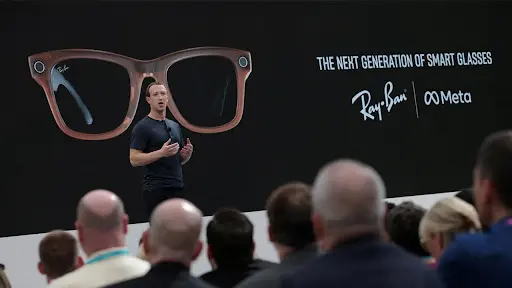
The Future of Meta Ray Ban Glasses in Fashion and Technology
- Strong Sales and Market Leadership
Smart glasses have gained immense popularity in recent years. The revenue growth was over 300% in 2025, and the smart glasses market had a 60% ownership by the industry boomer known as Meta.
- Blending Fashion and Function
A partnership with Ray-Ban and other luxury brands, like Prada, legitimizes smart glasses as stylish accessories worthy of modern ladies and men, while at the same time functioning as fully capable devices.
- AI-Driven Features
The Meta AI assistant, hands-free camera, open-ear speakers, and future updates like real-time translation and smarter content creation are central to their appeal.
- Hardware Roadmap Toward AR
Upcoming releases include third-generation Ray-Ban glasses in 2025 with mini displays and deeper AI integration, Quest 4 in 2026 with mixed reality features, and full AR glasses expected around 2028, marking a major leap in wearable computing.
- Expanding Product Range
Meta and EssilorLuxottica plan new versions to cater to varied lifestyles, broadening the consumer base beyond early adopters.
- Challenges and Competition
Battery life (about 30 minutes for on-device AI) remains a limitation, while tech giants and Chinese manufacturers are intensifying competition, pushing Meta to innovate continuously.
Wrapping up
So, what’s the verdict on Ray-Ban Meta smart glasses? They are managing the tricky balance between fashion and technology remarkably well. People don’t just want gadgets anymore; they want gear that looks good, feels natural, and makes life a little easier. Meta has nailed it with classic Ray-Ban style on the outside and AI-powered convenience on the inside.
The public clearly loves them. Sales are soaring, creators are capturing and streaming hands-free, and early adopters are showing the world what these glasses can do. There are challenges, of course. Battery life has limits, privacy concerns are real, and competitors are moving fast.
Looking ahead, the future is exciting. Smarter AI, mini-displays, mixed reality experiences, and eventually full AR could make these glasses feel like a personal assistant, navigator, and media hub all at once. For anyone who has dreamed of living in a sci-fi world while staying stylish, Meta and Ray-Ban are bringing that future closer one frame at a time.
The takeaway is clear. Smart glasses are not just coming; they are already here, ready to be worn with confidence, style, and a touch of awe.
FAQs
With Ray-Ban Meta Glasses, you can take photos and videos, listen to music, make and receive calls, send messages, live stream, and operate an AI assistant with easy voice commands, all while sporting a stylish and comfortable frame.
Currently, for Ray-Ban Meta smart glasses, there exist two generations, with the first being Ray-Ban Stories from 2021, the second from 2023, and a third advanced generation due to be released in late 2025.
No, Meta does not own the Ray Ban brands. EssilorLuxottica owns the brand and collaborated with Meta to produce Ray Ban Meta smart glasses. Meta works with EssilorLuxottica but does not own Ray-Ban.
The Ray-Ban Meta Gen 3 is still under development. In May 2023, Zuckerberg had already stated that next-gen smart glasses would be released in 2025, with a formal announcement expected to take place at Meta Connect in September 17-18, while the product's availability may be later in the year.
Ray Ban Meta smart glasses do not support Netflix because they were not built for video streaming. They instead capture photos and videos, play music, make calls, use Meta AI, and live-stream experiences.
Yes, you can listen to music and audio on Ray-Ban Meta glasses through open-ear speakers. They stream via Bluetooth, with touch and voice controls for playback, volume, and song selection, while keeping you aware of surroundings.
Yes, Ray-Ban Meta glasses work with both iPhone and Android devices. You’ll need iOS 14.2 or newer on iPhone, or Android 10 or later, plus the Meta View app and a Meta account.
The controversy with Ray-Ban Meta smart glasses centers on privacy risks, including unauthorized recording, weak consent signals, potential eavesdropping, data collection for AI, concerns about facial recognition misuse, and skepticism due to Meta’s history with user privacy.
No, Ray-Ban Meta sunglasses are not waterproof. They have an IPX4 rating, meaning they resist light rain and splashes but cannot withstand submersion or prolonged water exposure.
Yes, you can replace the lenses on Meta glasses with prescription or non-prescription options, either through Ray-Ban or certified optical providers.
